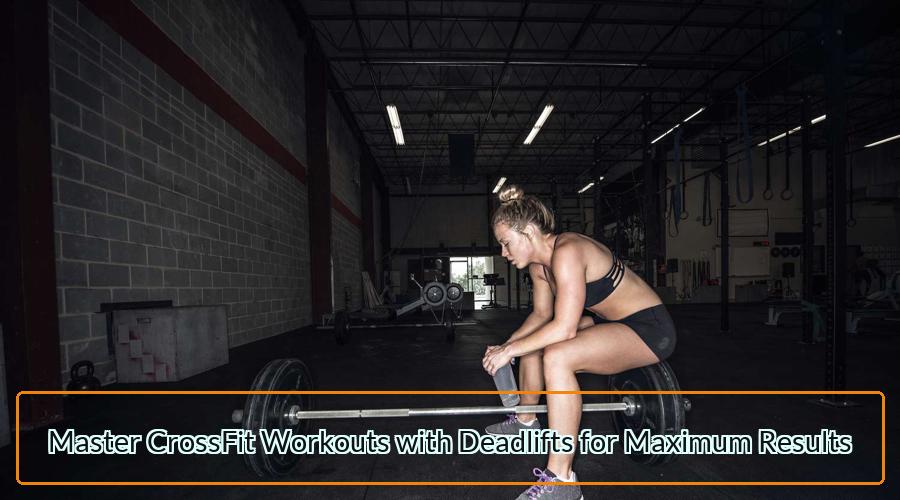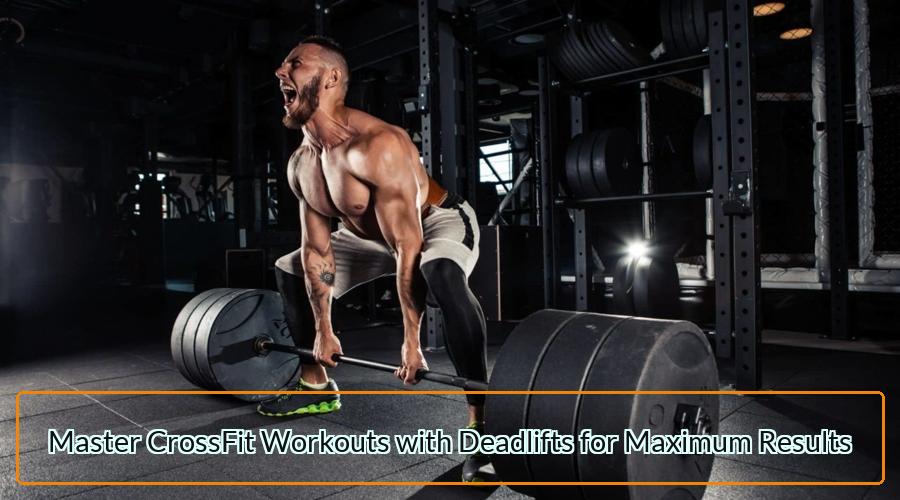
Are you looking to take your fitness to the next level and build strength and power? Look no further than incorporating deadlifts into your workouts. These powerful movements are a staple of many fitness programs, and for good reason. Not only do they work multiple muscle groups simultaneously, but they can also help to improve posture and prevent injury.
Incorporating deadlifts into your CrossFit routine can have numerous benefits. By focusing on proper form and gradually increasing weight, you can build a strong foundation of strength and power that will translate into better performance in your other CrossFit exercises. Deadlifts also have a functional aspect to them, as the lifting motion mimics movements we make in our daily lives, such as picking up heavy objects.
In this post, we’ll explore the benefits of deadlifts in a CrossFit context, provide tips for proper form, and offer some workout ideas to help you get started. Whether you’re new to CrossFit or a seasoned pro, incorporating deadlifts into your routine can help take your fitness to the next level.
Importance of Deadlifts in a Fitness Routine
Deadlifts are a compound exercise that engages multiple muscle groups in the body, making it one of the most effective exercises for building overall strength and power. The exercise primarily targets the lower body muscles such as the glutes, hamstrings, quads, and calves, as well as the upper body muscles like the back, shoulders, and arms.
In addition to building strength and power, deadlifts also help to improve posture and balance, increase bone density, and boost cardiovascular health. The lifting motion of deadlifts mimics everyday movements such as picking up heavy objects, making it a functional exercise that can have real-world benefits.
Incorporating deadlifts into a fitness routine can also help to prevent injury by strengthening the muscles around the spine and improving overall stability. This can be especially beneficial for athletes who participate in sports that require explosive movements or heavy lifting.
Read more about Turinabol vs Dianabol
Understanding Deadlifts
Description of deadlifts and their variations
Deadlifts are a weightlifting exercise that involves lifting a barbell or dumbbells off the ground, standing up with the weight, and then lowering it back down to the ground. This exercise is a compound movement that engages multiple muscle groups, making it one of the most effective exercises for building strength and power.
There are several variations of the deadlift exercise, including the conventional deadlift, sumo deadlift, and trap bar deadlift. The conventional deadlift is the most common variation and involves a narrow stance with the feet hip-width apart and hands placed on the bar just outside the legs. The sumo deadlift, on the other hand, has a wider stance with the feet pointed outwards and hands placed inside the legs. Finally, the trap bar deadlift involves lifting the weight with a hexagonal bar instead of a straight bar, which can be easier on the back and hips.
Each variation of the deadlift targets slightly different muscle groups, and athletes may choose to incorporate different variations depending on their fitness goals and individual preferences.
Proper form and technique
Proper form and technique are crucial when performing deadlifts to prevent injury and maximize the benefits of the exercise. Here are some key elements of proper form:
- Begin with feet hip-width apart, toes pointed forward, and hands placed on the barbell just outside the legs.
- Keep the back straight and engage the core muscles.
- Lift the bar by driving through the heels and pushing the hips forward.
- Keep the bar close to the body throughout the movement.
- Lower the weight slowly and with control, keeping the back straight.
It is important to start with a lighter weight and focus on proper form before increasing weight. Additionally, incorporating warm-up exercises to engage the muscles targeted by deadlifts can help to prevent injury.
Common mistakes to avoid
There are several common mistakes to avoid when performing deadlifts, including:
- Rounding the back: This can put unnecessary strain on the back and increase the risk of injury. To avoid this, keep the back straight and engage the core muscles throughout the movement.
- Lifting with the arms: Deadlifts should be driven by the legs and hips, not the arms. Keep the arms straight and use them only to hold onto the bar.
- Using too much weight: Starting with a weight that is too heavy can compromise form and increase the risk of injury. Begin with a lighter weight and focus on proper form before increasing weight.
- Neglecting warm-up exercises: Engaging the muscles targeted by deadlifts through warm-up exercises can help to prevent injury and improve performance.
By avoiding these common mistakes and focusing on proper form and technique, athletes can safely and effectively incorporate deadlifts into their fitness routine.
Building Strength and Power with Deadlifts
How deadlifts improve strength and power
Deadlifts are one of the most effective exercises for building strength and power in the body. The lifting motion engages multiple muscle groups, including the legs, back, and arms, making it a compound movement that can have a significant impact on overall fitness.
By lifting heavy weights with proper form and technique, athletes can increase their strength and power in the muscles targeted by deadlifts. This translates into improved performance in other exercises and activities, such as running, jumping, and throwing. Additionally, deadlifts can help to improve overall posture and balance, reducing the risk of injury in other physical activities.
Muscle groups targeted
Deadlifts primarily target the lower body muscles, including the glutes, hamstrings, quads, and calves. However, the exercise also engages several upper body muscles, including the back, shoulders, and arms.
Engaging multiple muscle groups simultaneously is beneficial for overall strength and power, as it allows athletes to lift heavier weights and improve overall fitness more efficiently. By targeting both upper and lower body muscles, deadlifts can help to improve overall functional fitness, making it easier to perform everyday activities that require strength and power.
Read more about Dumbbell Narrow Squats
Importance of progressive overload for muscle growth
To continue building strength and power with deadlifts, it is important to incorporate progressive overload into a fitness routine. This means gradually increasing the weight lifted over time to challenge the muscles and promote muscle growth.
Incorporating progressive overload can be done in several ways, such as increasing weight, increasing reps or sets, or decreasing rest time between sets. By challenging the muscles in new ways, athletes can continue to build strength and power with deadlifts.
However, it is important to incorporate progressive overload safely and with proper form to avoid injury. Starting with a weight that is too heavy can compromise form and increase the risk of injury. Additionally, incorporating rest days into a fitness routine is crucial to allow the muscles to recover and grow.
Incorporating Deadlifts in a CrossFit Routine
Deadlifts are a great addition to a CrossFit routine, as they target multiple muscle groups and can improve overall strength and power. Here are some tips for incorporating deadlifts into a CrossFit program:
- Determine your goals: Consider why you want to incorporate deadlifts into your CrossFit routine. Are you looking to build overall strength and power, or are you targeting specific muscle groups? Understanding your goals can help you choose the right deadlift variation and weight for your workout.
- Choose the right deadlift variation: There are several variations of the deadlift exercise, each targeting slightly different muscle groups. Consider which variation aligns with your goals and fitness level. The conventional deadlift is the most common variation, while the sumo deadlift and trap bar deadlift are also popular options.
- Focus on proper form and technique: Proper form and technique are crucial when performing deadlifts, especially in a CrossFit setting where fatigue can compromise form. Start with a lighter weight and focus on proper form before increasing weight. Incorporate warm-up exercises to engage the muscles targeted by deadlifts and prevent injury.
- Integrate deadlifts into WODs: Deadlifts can be incorporated into a variety of CrossFit workouts, such as EMOMs, AMRAPs, and chipper-style workouts. Consider pairing deadlifts with other exercises that target different muscle groups to create a well-rounded workout.
- Modify for beginners or injuries: Deadlifts can be modified for beginners or those with injuries. Starting with a lighter weight or using dumbbells instead of a barbell can make the exercise more accessible. Additionally, coaches can provide modifications or alternatives to the deadlift exercise if necessary.
Incorporating deadlifts into a CrossFit routine can have numerous benefits, including improved strength, power, and overall fitness. By focusing on proper form and technique, choosing the right variation and weight, and integrating deadlifts into a well-rounded workout, athletes can safely and effectively incorporate deadlifts into their CrossFit routine.

Crossfit Workouts with Deadlifts
Here are three sample crossfit workouts with deadlifts:
- “Deadlift Burner”
- 5 rounds for time:
- 15 deadlifts (225/155 lbs)
- 20 box jumps (24/20 in)
- 25 wall balls (20/14 lbs)
This workout features high reps of deadlifts combined with box jumps and wall balls, making it a challenging full-body workout. Athletes should choose a weight for the deadlift that challenges them but allows for proper form and technique.
- “Deadlift Strength”
- 5 sets of 5 reps:
- Deadlift (build to a heavy set)
This workout focuses on building strength in the deadlift by gradually increasing weight over five sets of five reps. Athletes should start with a weight that allows for proper form and technique and gradually increase weight with each set.
- “Deadlift and Run”
- For time:
- 21-15-9
- Deadlifts (225/155 lbs)
- 400m run after each round
This workout features moderate reps of deadlifts combined with a 400m run after each round, making it a great conditioning workout. Athletes should choose a weight for the deadlift that challenges them but allows for proper form and technique, and focus on maintaining a consistent pace throughout the workout.
Remember, proper form and technique are crucial when performing deadlifts. It’s always a good idea to consult with a coach or personal trainer to ensure proper form and technique before incorporating deadlifts into a workout routine.
Read more about 10 Different Kinds of Squats
Conclusion
Incorporating crossfit workouts with deadlifts can have numerous benefits, including improved strength, power, and overall fitness. By choosing the right deadlift variation, focusing on proper form and technique, and integrating deadlifts into well-rounded workouts, athletes can safely and effectively incorporate deadlifts into their CrossFit program.
Deadlifts are a compound exercise that engage multiple muscle groups in the body, making them one of the most effective exercises for building overall strength and power. Deadlifts primarily target the lower body muscles, including the glutes, hamstrings, quads, and calves, but also engage several upper body muscles, including the back, shoulders, and arms.
To continue building strength and power with deadlifts, it’s important to incorporate progressive overload into a fitness routine. Gradually increasing weight, reps, or sets can challenge the muscles and promote muscle growth. However, it’s important to incorporate progressive overload safely and with proper form to avoid injury.
Incorporating deadlifts into a CrossFit program can be done through a variety of workout routines, such as burners, strength-focused workouts, or conditioning workouts. By choosing workouts that align with your goals and fitness level, you can safely and effectively incorporate deadlifts into your CrossFit program.